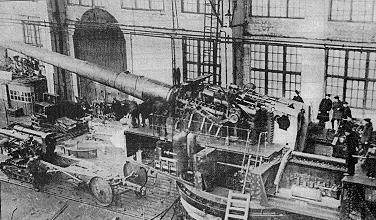|
As originally planned, this weapon would have had long range and good penetration power, but also would have had a very short barrel life, all characteristics of Italian large-caliber naval guns. A total of twelve guns were started from 1939 to 1940 and by June 41 all were either completed or nearly completed. However, work was halted shortly after the start of World War II. Only one gun was proof fired and gunnery trials with it had uneven results. The gun itself was considered to be a success, but the rounds and propellant were of low quality, resulting in large dispersion patterns. This gun was used in the defense of Leningrad and one of its shells is now on display at the Central Naval Museum in Petersburg, as shown below. The gun and its mounting are currently stored (2010) at Rjevsky Artillery Range. Actual bore diameter was 406.4 mm (16.0"). |

B-37 gun at the factory
|

406 mm/50 (16") APC now at Central Naval
Museum, St. Petersburg, Russia
|
|
Images at Rjevsky Artillery Range (Russian) |